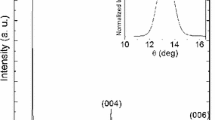Abstract
Temperature effects in the highly oriented pyrolytic graphite (HOPG) under bombardment by 86Kr (253 MeV) and 209Bi (710 MeV) heavy ions are studied in the framework of a three-dimensional thermal spike model. It is shown that the surface temperature of an HOPG target under bombardment by bismuth ions can exceed the sublimation temperature at particular values of the electron-phonon interaction coefficient. At the same time, the temperature at the target surface during bombardment of HOPG by krypton ions does not exceed the sublimation temperature over a wide range of variations in the electron-phonon interaction belongs. The calculations allow the explanation of the observed changes in the surface structure of HOPG single crystal under bombardment by 209Bi and 86Kr ions.
Similar content being viewed by others
References
Zh. I. Alferov, Usp. Fiz. Nauk 172(9), 1069 (2002).
N. N. Ledentsov, V. M. Ustinov, Zh. I. Alferov, et al., Fiz. Tekh. Poluprovodn. 32, 385 (1998) [Semiconductors 32, 343 (1998)].
V. M. Mikhushkin, S. E. Sysoev, and Yu. S. Gordeev, Izv. Akad. Nauk, Ser. Fiz. 66(4), 588 (2002).
S. Bouneau, A. Brunelle, S. Della-Negra, et al., Phys. Rev. B 65(14), 144 106 (2007).
D. Fink and L. Chadderton, Radiat. Eff. Defects Solids 160, 67 (2005).
Yu. V. Martynenko, in Summary of Science and Technology. Beams of Charged Particles (VINITI, Moscow, 1993), p. 82 [in Russian].
F. F. Komarov, Usp. Fiz. Nauk 173(12), 1287 (2003) [Phys.-Usp. 46, 1253 (2003)].
G. A. Bleikher, V. P. Krivobokov, and O. V. Pashchenko, Thermal Mass Transfer in Solid under the Action of Power Beams of Charged Particles (Nauka, Novosibirsk, 1999) [in Russian].
F. Seitz and J. S. Koehler, Solid State Phys. 2, 251 (1956).
I. M. Lifshits, Dokl. Akad. Nauk SSSR 109(6), 1109 (1956).
I. M. Lifshits, M. I. Kaganov, and L. V. Tanatarov, At. Energ. 6, 391 (1959).
M. I. Kaganov, I. M. Lifshits, and L. V. Tanatarov, Zh. Eksp. Teor. Fiz. 31(2), 232 (1956) [Sov. Phys. JETP 4, 173 (1956)].
Ya. E. Geguzin, M. I. Kaganov, and I. M. Lifshits, Fiz. Tverd. Tela 15(8), 2425 (1973) [Sov. Phys. Solid State 15, 1612 (1973)].
A. A. Davydov and A. I. Kalinichenko, VANT, Ser. Fiz. Radiats. Povrezhdenii Radiatz. Materialoved. 3(36), 27 (1985).
R. L. Fleisher, P. B. Price, and R. M. Walker, J. Appl. Phys. 36(11), 3645 (1965).
R. L. Fleisher, P. B. Price, and R. M. Walker, Nuclear Track in Solids (Univ. of California, Los Angeles, 1975), p. 273.
I. A. Baranov, Yu. V. Martynenko, S. O. Tsepelevich, and Yu. N. Yavlinskii, Usp. Fiz. Nauk 156(3), 477 (1988) [Sov. Phys.-Usp. 31, 1015 (1988)].
A. S. Fialkov, Carbon and Carbon-Based Interlayer Compounds and Composites (Aspekt Press, Moscow, 1997) [in Russian].
Z. G. Wang, Ch. Dufour, E. Paumier, et al., J. Phys.: Condens. Matter 6(34), 6733 (1994).
M. Toulemonde, Nucl. Instrum. Methods Phys. Res., Sect. B 156(1–4), 1 (1999).
R. Neumann, Nucl. Instrum. Methods Phys. Res., Sect. B 151(1–4), 42 (1999).
S. Furuno, H. Otsu, K. Hojou, et al., Nucl. Instrum. Methods Phys. Res., Sect. B 107(1–4), 223 (1996).
Ch. Dufour, A. Audouard, F. Beuneu, et al., J. Phys.: Condens. Matter 5(26), 4573 (1993).
A. Audouard, E. Balanzat, J. C. Jousset, et al., J. Phys: Condens. Matter 5(5), 995 (1993).
Ch. Dufour, E. Paumier, and M. Toulemonde, Radiat. Eff. Defects Solids 126, 119 (1993).
S. A. Karamian, Yu. Ts. Oganessian, and V. N. Bugrov, Nucl. Instrum. Methods Phys. Res., Sect. B 43(2), 153 (1989).
A. Yu. Didyk, Metally 3, 128 (1995).
I. V. Amirkhanov, A. Yu. Didyk, E. V. Zemlyanaya, et al., Pis’ma Fiz. Elem. Chastits At. Yadra 3(1), 63 (2006) [Phys. Part. Nucl. 3, 37 (2006)].
I. V. Amirkhanov, A. Yu. Didyk, N. R. Sarkar, et al., Pis’ma Fiz. Elem. Chastits At. Yadra 3(5), 80 (2006) [Phys. Part. Nucl. 3, 320 (2006)].
I. V. Amirhanov, A. Yu. Didyk, D. Z. Muzafarov, et al., Crystallogr. Rep. 51(Suppl. 1), 32 (2006).
I. V. Amirkhanov, A. Yu. Didyk, A. Khofman, et al., Fiz. Elem. Chastits At. Yadra 37(6), 1592 (2006) [Phys. Part. Nucl. 37, 837 (2006)].
I. V. Amirhanov, A. Yu. Didyk, D. Z. Muzafarov, et al., Crystallogr. Rep. 51(Suppl. 1), 32 (2006).
M. R. P. Waligorski, R. N. Hamm, and R. Katz, Nucl. Tracks Radiat. Meas. 11, 306 (1986).
I. S. Bitensky, P. Dimirev, and B. U. Sundqust, Nucl. Instrum. Methods Phys. Res., Sect. B 82, 356 (1998).
A. Yu. Didyk, S. V. Latyshev, V. K. Semina, et al., Pis’ma Zh. Tekh. Fiz. 26(17), 1 (2000) [Tech. Phys. Lett. 26, 751 (2000)].
Yu. N. Cheblukov, A. Yu. Didyk, A. S. Fedotov, et al., J. Adv. Mater. 5, 42 (2001).
L. A. Vlasukova, A. Yu. Didyk, F. F. Komarov, et al., Poverkhnost 8, 34 (2006).
L. A. Vlasukova, A. Yu. Didyk, F. F. Komarov, et al., Poverkhnost 1, 50 (2006).
Physical Quantities: A Handbook, Ed. by I. S. Grigorjev and E. Z. Meilikhova (Energoatomizdat, Moscow, 1991), p. 1232 [in Russian].
A. A. Samarskii, in Theory of Differential Schemes (Nauka, Moscow, 1983), p. 258 [in Russian].
A. A. Samarskii and A. V. Gulin, in Stability of Differential Schemes (Nauka, Moscow, 1973), p. 308 [in Russian].
L. I. Turchak, in Principles of Numerical Methods (Nauka, Moscow, 1987), p. 277 [in Russian].
Author information
Authors and Affiliations
Additional information
Original Russian Text © I.V. Amirkhanov, A.Yu. Didyk, D.Z. Muzafarov, I.V. Puzynin, T.P. Puzynina, N.R. Sarkar, I. Sarkhadov, Z.A. Sharipov, 2008, published in Poverkhnost’. Rentgenovskie, Sinkhrotronnye i Neitronnye Issledovaniya, No. 5, pp. 3–12.
Rights and permissions
About this article
Cite this article
Amirkhanov, I.V., Didyk, A.Y., Muzafarov, D.Z. et al. Application of the thermal spike model for explanation of variations of surface structure of highly oriented pyrolytic graphite under bombardment by 86Kr and 209Bi fast ions with high ionization energy loss. J. Surf. Investig. 2, 331–339 (2008). https://doi.org/10.1134/S1027451008030014
Received:
Published:
Issue Date:
DOI: https://doi.org/10.1134/S1027451008030014




